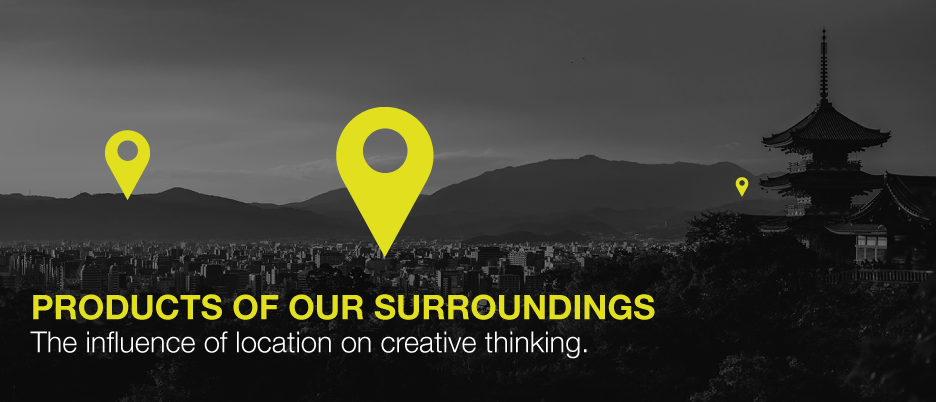Social addictions.
Nothing gets our inspiration flowing like a good, juicy blog post. Read about what we’ve been working on (our latest launches), what we can’t stop thinking about (design trends, industry happenings and new partnerships) and what we think you should know (expert branding insights and probably some stuff about dogs).
Check back often—we’re quite chatty when we want to be.
Products of our Surroundings
There’s no doubt that with any creative endeavor, inspiration serves as an important aspect of the concepting phase. Good design doesn’t exist in a vacuum and great ideas do not just appear out of nothing. We tend to pull sources of inspiration from all around us; the places we go, the people we meet and the media we consume. Whether on a conscious level or subliminally, our surroundings have a creative influence on the work we do.

This idea brings to mind one of Derren Brown’s Trick of the Mind episodes in which he creates an experiment in subliminal messaging. In this particular episode a pair of advertising creatives are briefed in creating imagery, a name, logo and tagline for a fictional taxidermy store. In the end it’s revealed that the route the taxi took the two designers was carefully curated to manipulate the creative process. This ultimately led the designers to create something very similar to what the host had made beforehand. Although the power of subliminal messaging is often used as an example of the way modern advertising manipulates consumer behavior, it’s also a glance into the way we pull inspiration from our surroundings, whether we’re aware of it or not.
CREATIVE PSYCHOLOGY
Mihaly Csikszentmihalyi, Hungarian-American Psychologist and leading researcher in the area of positive psychology, applied much of his ideas on examining the creative process and nature of creative people. In his 1996 book Creativity: The Psychology of Discovery and Invention, Csikszentmihalyi affirms that “Creativity does not happen inside people’s heads, but in the interaction between a person’s thoughts and a sociocultural context.” In this sense, creativity happens when our surroundings act as a catalyst to our thoughts, the way a spark will ignite a combustible material and create an explosion. We pull ideas from the culture and society that we’re exposed to and together with our previous experiences and knowledge, create something novel.
It’s no surprise that surroundings play a big role in creative thinking when you look at certain regions or cities that are well known for their creative output. Inkifi has compiled a list of the most creative cities. The metrics used take into account the number of theaters, music venues, art galleries and museums, as well as factors like noteworthy architecture and monuments. When compared with AdForum’s list of top cities for talent, the similarities are hard to ignore. Unsurprisingly cities like Paris, New York, Chicago, Amsterdam and Los Angeles top both lists. Another glaring similarity is that these are all major, global cities. This begs the question: Can you find creativity outside of these major hubs?
SMALL TOWN, BIG ENERGY
Creative Vitality Suite took similar metrics, but on a per-capita basis. Based on population they compiled a list of the most creative small cities. It came as no shock to us that our home base of Boulder, Colorado came in at number 3 on this list. According to the study, Boulder has twice as many fine art dealers as the national average and creative jobs were 63% more concentrated in the area when compared to similar size regions. From museums and galleries to the natural wonders, there’s no shortage of inspiration and having a major university in the University of Colorado brings new and fresh ideas to the city.
BENEFITS OF DIVERSITY
While smaller towns like Boulder can contain a concentrated amount of creativity, there is still one thing that major, global cities can offer that smaller cities can’t: diversity. According to DataUsa as of 2020, 93.8% of Boulder’s residents were U.S. citizens, slightly higher than the national average. A striking 79.3% of the population identify as white (non-hispanic). Boulder is not alone as many of the cities on the creative small city list have similar demographics. Compare that to cities like New York or Chicago that have a percentage of the population identifying as white (non-hispanic) as 31.9% and 33.3% respectively. Residents of these global cities have a sort of natural exposure to different cultures and different ideas.
This is not to suggest that creatives in Boulder are living under a rock. In fact, many of us here at Oblique come from–or currently work from–one of the cities that appear on the most creative list. We take pride in being well traveled. In 2018 Oblique closed up its brick and mortar shop to benefit from the flexibility that co-working spaces offer. The following year, Principal and Creative Director Janice Ferrante along with Account Manager Laurel Van Woerkom took that flexibility further (quite literally) working from co-share workspaces in 12 different countries as part of a Remote Year program. This flexibility proved ideal the following year when the world shut down due to a global pandemic, but that’s a story for another article all on its own.
There are certainly a lot of factors that go into the creative process, but there’s no doubt that our surroundings play a big part. Everything from the architecture to the people we interact with all play a role in our creative thinking and problem solving. Gaining new perspectives leads to new ideas and solutions. Creativity does not happen in a vacuum and our recommendation is to get out there! Whether it’s a trip abroad or just a trip to the museum, you never know where you’ll find your next source of inspiration.
